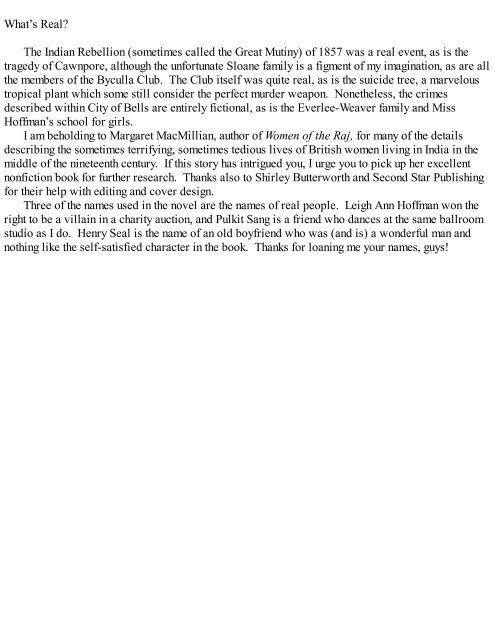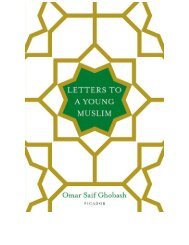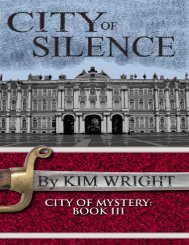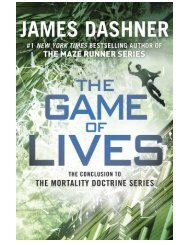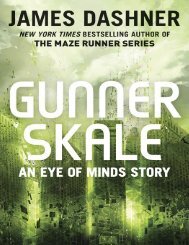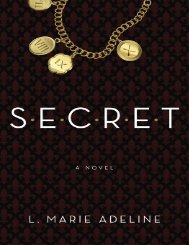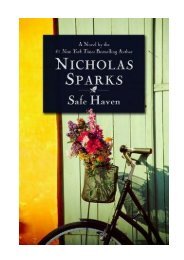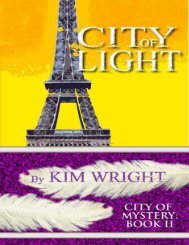- Page 2 and 3:
CITY OF BELLS City of Mystery, Book
- Page 4 and 5:
how unpleasant this particular old
- Page 6 and 7:
ace up his sleeve - his courtship o
- Page 8 and 9:
forgetting, Rayley, that you were g
- Page 10 and 11:
who might -“ “Read it,” Geral
- Page 12 and 13:
But I wanted to see India. It was t
- Page 14 and 15:
“I fear I am being obscure,” Ge
- Page 16 and 17:
expanded with his career.” “I h
- Page 18 and 19:
Chapter Three Scotland Yard August
- Page 20 and 21:
with a distinguished record of his
- Page 22 and 23:
“The letter was obviously compose
- Page 24 and 25:
cabins, both coming and going, whic
- Page 26 and 27:
evidenced by the fact I asked you h
- Page 28 and 29:
“But the extremities go first sim
- Page 30 and 31:
their level of detective skill, it
- Page 32 and 33:
In the beginning of the fourth week
- Page 34 and 35:
member of the crew. These were not
- Page 36 and 37:
ecome an energetic and modern city,
- Page 38 and 39:
“Whyevernot? I should dearly like
- Page 40 and 41:
“Shall we tell you what we need?
- Page 42 and 43:
But the truly important thing is th
- Page 44 and 45:
“Silly indeed,” Geraldine agree
- Page 46 and 47:
peered out. She was rewarded with t
- Page 48 and 49:
said, jerking his head toward anoth
- Page 50 and 51:
Weaver shook his head impatiently.
- Page 52 and 53:
Chapter Eight The Weaver House 3:15
- Page 54 and 55:
equest of its occupant than anythin
- Page 56 and 57:
“Not a waste of time at all,” h
- Page 58 and 59:
sent us, not accompanied us, and I
- Page 60 and 61:
“No,” Rayley said. “What you
- Page 62 and 63:
“Bravo, Detective Welles. And can
- Page 64 and 65:
where the bodies of so many victims
- Page 66 and 67:
its highest point and wit is at its
- Page 68 and 69:
“Tell Mrs. Morrow Amy will likely
- Page 70 and 71:
comrades. Apparently only one among
- Page 72 and 73:
and India was a large country. No o
- Page 74 and 75:
Geraldine sat in her own bed, the s
- Page 76 and 77:
Morrow that the poor woman is scrap
- Page 78 and 79:
need for the muslin and I named an
- Page 80 and 81:
“If there used to be two birds?
- Page 82 and 83:
“You mean the fathers of the girl
- Page 84 and 85:
“He told me he drives by here som
- Page 86 and 87:
Chapter Twelve The Tucker House 12:
- Page 88 and 89:
“The suicide tree doesn’t make
- Page 90 and 91:
sort of creature lies beneath. “W
- Page 92 and 93:
the servants -“ “Speaking of su
- Page 94 and 95:
“My uncle get me job,” said Fel
- Page 96 and 97:
elatives in England. At least accor
- Page 98 and 99:
“Weaver and Everlee, I presume,
- Page 100 and 101:
and off, leaving that solemn task t
- Page 102 and 103:
her bank draft be returned. Hardly
- Page 104 and 105:
who read quickly, then shook his he
- Page 106 and 107:
the murder investigation.” “I d
- Page 108 and 109:
composing herself a bit. Pulling he
- Page 110 and 111:
the air outside the open windows ha
- Page 112 and 113:
ingest his mistress’s medication?
- Page 114 and 115:
must never happen again.” Geraldi
- Page 116 and 117:
although they were standing too far
- Page 118 and 119:
“I was also introduced to your au
- Page 120 and 121:
The man does not seem at all well,
- Page 122 and 123:
“And Sang was with you.” Weaver
- Page 124 and 125:
“And Rose.” “And Rose. Of cou
- Page 126 and 127:
many memories to contend with, so m
- Page 128 and 129:
Morass sniggered. “Hardly. Fewer
- Page 130 and 131:
was the same reassuring manner that
- Page 132 and 133:
onions.” Adelaide entered slowly.
- Page 134 and 135:
Miss Hoffman, sitting across from t
- Page 136 and 137:
“When the men came down to greet
- Page 138 and 139:
processional. She had abandoned her
- Page 140 and 141: Chapter Eighteen Did she remember o
- Page 142 and 143: the years. And the man who had hire
- Page 144 and 145: Chapter Nineteen Cawnpore 11:20 AM
- Page 146 and 147: focus to cooperating with the Vicer
- Page 148 and 149: “Their families would certainly c
- Page 150 and 151: “I like it well enough,” he sai
- Page 152 and 153: gingerly felt his ribs, then took a
- Page 154 and 155: Sirs? Before we risk trying to move
- Page 156 and 157: most likely.” But Davy was shakin
- Page 158 and 159: Chapter Twenty The Tucker House 11:
- Page 160 and 161: een in Bombay. It is my reward. A s
- Page 162 and 163: only when it is very late and very
- Page 164 and 165: “And I see the end of me. I am un
- Page 166 and 167: combined with old age and an almost
- Page 168 and 169: Trevor flipped the photograph back
- Page 170 and 171: Chapter Twenty-Two Bombay Jail Infi
- Page 172 and 173: oth. The truth is that I was attrac
- Page 174 and 175: “I can only assume that Rose lied
- Page 176 and 177: Geraldine’s heart, which had spen
- Page 178 and 179: inclinations…Oh, do not misunders
- Page 180 and 181: elative who swears to fend for her.
- Page 182 and 183: Chapter Twenty-Three Bombay Jail 1:
- Page 184 and 185: his palm and said “This is the wo
- Page 186 and 187: she was but six years old. It burns
- Page 188 and 189: might say, or perhaps an early tea.
- Page 192: What’s next? Next up is a bargain


